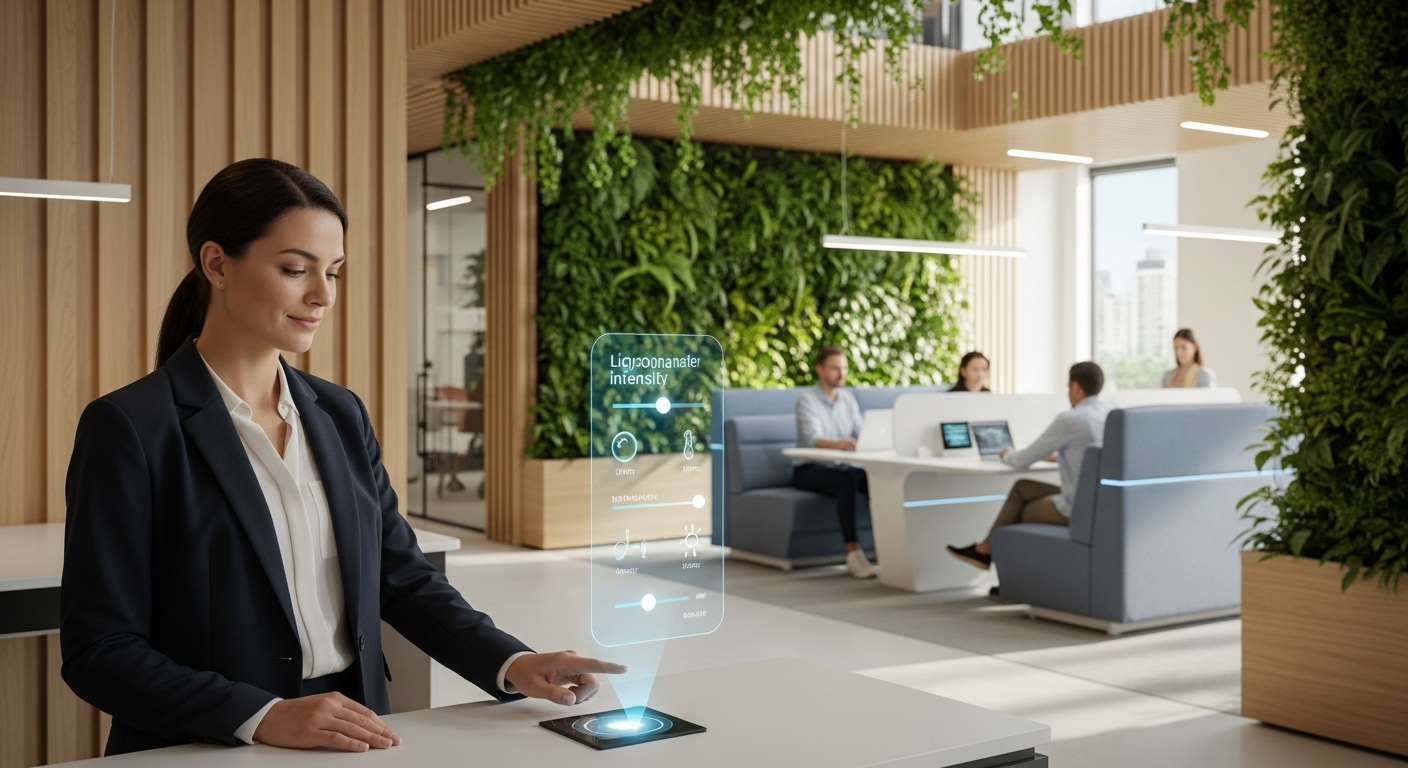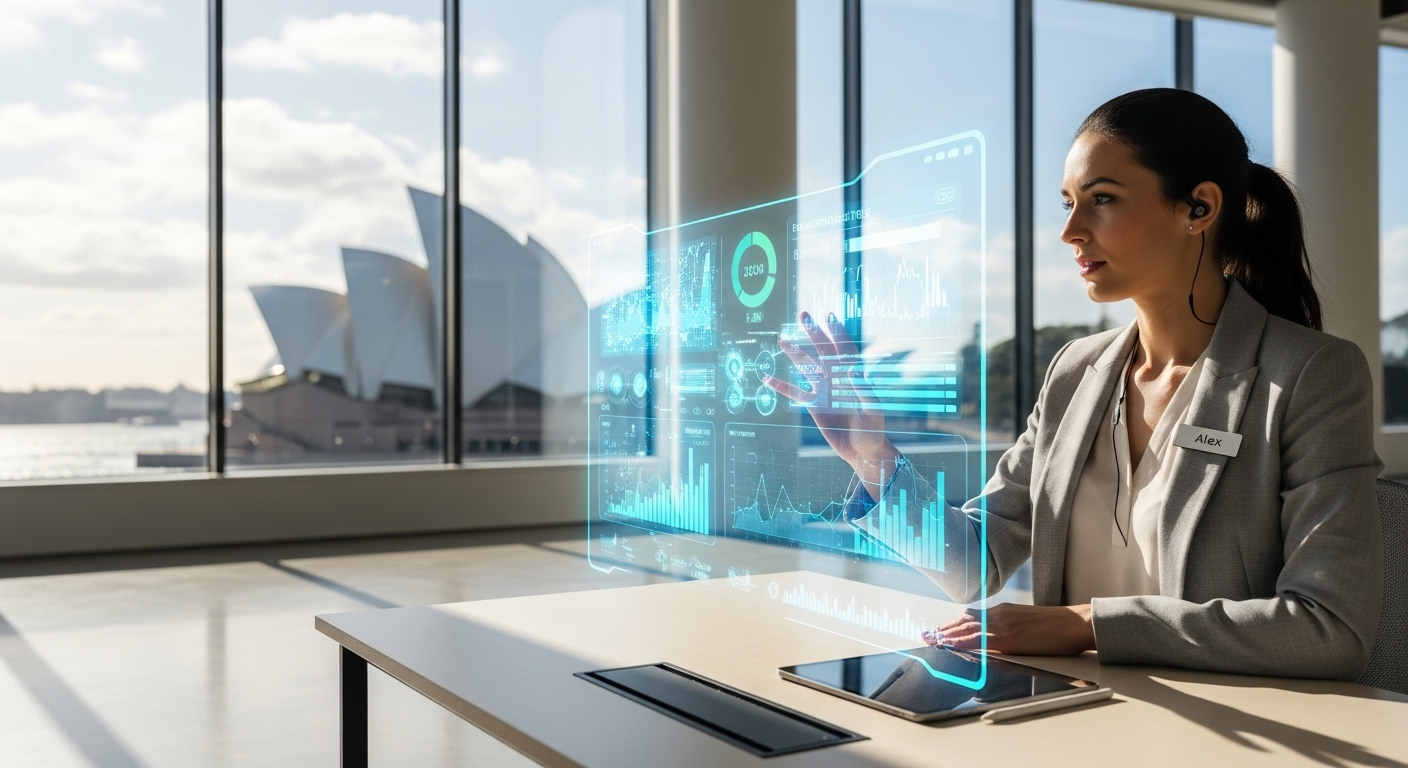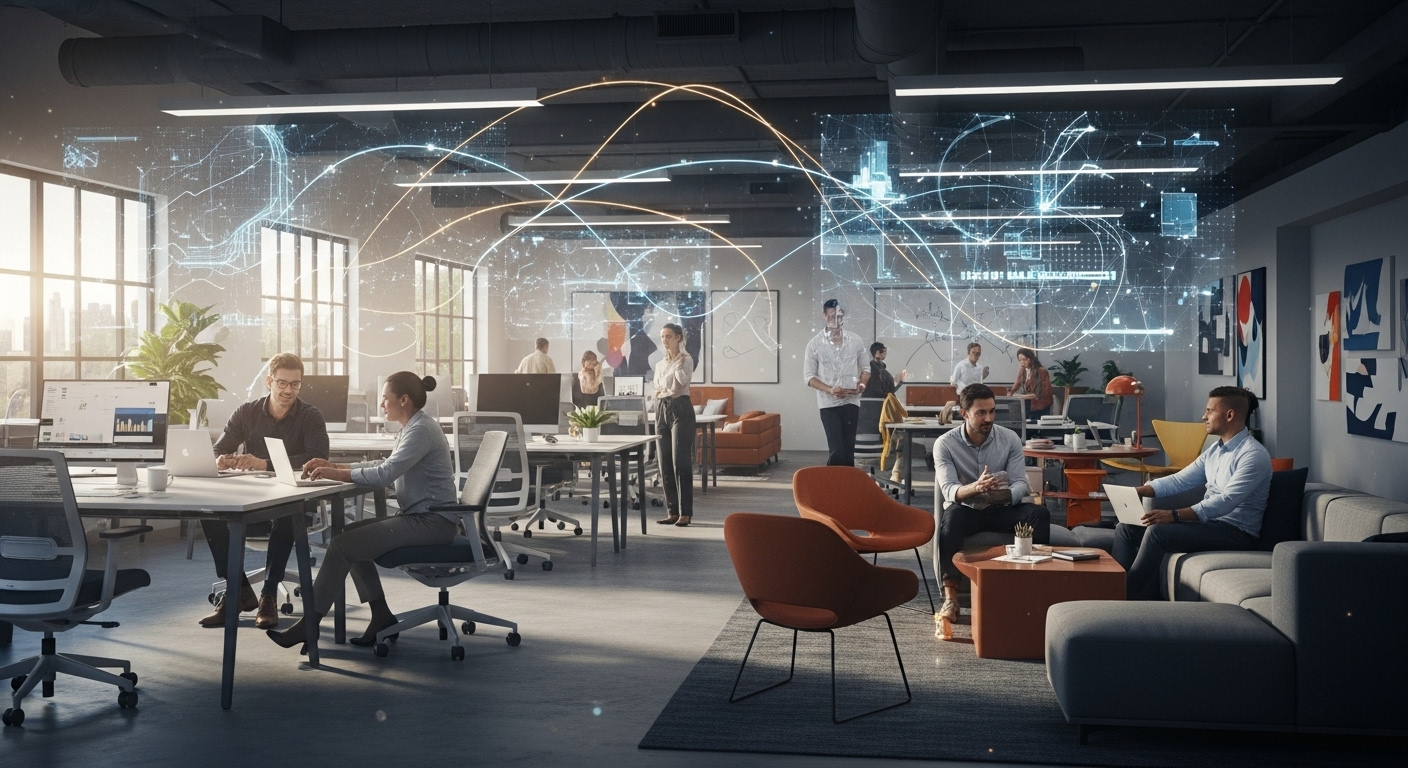The traditional office is a passive container for work, a static structure of walls, desks, and chairs. But what if your workspace could do more? What if it could listen, learn, and adapt not just to the day’s schedule, but to your individual needs in real time? This isn’t science fiction; it’s the emerging reality of the ‘Listening Office.’ As we move deeper into the future of work, the focus is shifting from simple automation—like lights on a timer—to creating truly intelligent environments powered by human-centric Artificial Intelligence. This new paradigm uses a vast network of sensors and smart devices to gather insights about how spaces are actually used, transforming the office from a mere facility into an active partner in productivity and well-being. This article explores the evolution of this concept, detailing the core technologies that form its foundation, the critical role of AI as its brain, the tangible benefits for employees, the ethical considerations we must navigate, and what the next phase of this workplace revolution looks like.
From Smart to Sentient: The Evolution of Office Environments
The journey toward the Listening Office has been a gradual but accelerating evolution. The first wave of ‘smart’ technology in commercial buildings focused on centralized, macro-level efficiencies. Think of building management systems (BMS) that automated HVAC and lighting schedules for an entire floor or building based on predictable, static patterns of use. While a significant step up from manual controls, this approach was rigid and impersonal, often failing to account for the dynamic and varied nature of a modern workday. The introduction of the Internet of Things (IoT) marked the next major leap, decentralizing intelligence and bringing it closer to the individual. Suddenly, standalone devices like smart thermostats, motion-sensing lights, and connected security cameras began to proliferate. However, these technologies often operated in silos, creating a fragmented ecosystem rather than a cohesive, intelligent whole. The true revolution, and the one that defines the Listening Office, is the integration of these disparate IoT endpoints with a powerful AI and machine learning backend. This creates a ‘digital twin’—a virtual, real-time model of the physical office. This model doesn’t just know the office layout; it understands occupancy levels, air quality, ambient noise, light intensity, and even traffic flow. It moves beyond the facility manager’s preset schedule to a model of continuous, dynamic optimization. The office stops being a place where work happens and starts becoming an environment that actively works to support its occupants, learning from their behaviors to create a more efficient, comfortable, and productive space for everyone.
The Core Components of a Listening Infrastructure
At the heart of any Listening Office is a sophisticated infrastructure of interconnected hardware, all feeding data into a central intelligence system. These are not just gadgets; they are the sensory organs of the building. The most fundamental components are IoT sensors. These include passive infrared (PIR) sensors to detect presence in rooms and at desks, enabling real-time occupancy mapping. Environmental sensors constantly monitor variables crucial for well-being and cognitive performance, such as CO2 levels, volatile organic compounds (VOCs), temperature, humidity, and ambient light. This data allows the HVAC and lighting systems to make micro-adjustments that go far beyond a simple thermostat setting, ensuring optimal conditions room by room. Beyond sensors, smart furniture is becoming a key component. Desks can remember a user’s preferred standing and sitting heights, adjusting automatically upon their arrival. Chairs can monitor posture and provide gentle feedback. Even the physical booking systems for desks and meeting rooms are part of this network. When an employee books a space via an app, that data point informs the system about demand patterns, cleaning schedules, and resource allocation. This integrated network of hardware transforms the entire office into a rich source of operational data. It’s the difference between asking ‘Is this meeting room booked?’ and the system knowing ‘This room is booked, but occupancy sensors show it’s empty, so let’s release it back into the pool.’ This web of technology forms a robust foundation, a digital nervous system that allows the office to feel and respond to its environment and inhabitants with unprecedented granularity.
The Brains of the Operation: The Role of Human-Centric AI
If IoT sensors are the nervous system of the Listening Office, then Artificial Intelligence is its brain. Raw data from thousands of endpoints is meaningless without the ability to interpret it, identify patterns, and make intelligent decisions. This is where human-centric AI comes into play. Unlike traditional AI focused solely on mechanical efficiency, human-centric AI prioritizes the experience, well-being, and productivity of the people within the space. Its algorithms are designed to balance competing goals: for instance, maximizing energy savings from the HVAC system without ever letting CO2 levels rise to a point that impairs cognitive function. Machine learning models analyze historical and real-time data to move from reactive adjustments to predictive actions. For example, the AI can learn the typical ebb and flow of a department and pre-cool a project room just before a team’s scheduled weekly sync, ensuring it’s comfortable the moment they walk in. It can analyze space utilization data to provide facility managers with concrete recommendations, such as converting a consistently underused block of desks into a much-needed collaboration zone. This data-driven approach removes guesswork from strategic workplace design. A powerful example of this AI in action is its ability to manage resource contention.
“By analyzing long-term usage patterns, AI can identify teams that frequently require collaborative spaces and proactively suggest booking availabilities that align with their project cadences, effectively acting as an intelligent workplace assistant,”
as noted by a recent report from a leading property technology firm. Ultimately, the AI layer is what elevates a collection of smart devices into a truly intelligent ecosystem. It’s the silent, invisible force that orchestrates a seamless, responsive, and supportive workplace experience.
Personalization at Scale: A Day in the Life of an Employee
To truly grasp the impact of a Listening Office, it’s helpful to walk through a typical day. Imagine an employee named Alex. As Alex approaches the building, their smartphone provides secure, touchless entry, simultaneously alerting the system of their arrival. Alex has a ‘focus block’ scheduled in their calendar for the morning. The workplace app, powered by the central AI, has already recommended and reserved a ‘quiet pod’ in a low-traffic area. When Alex arrives at the pod, the lighting automatically adjusts to their pre-set preference for focused work—a cool, bright white light. The environmental system ensures the air quality is optimal and the temperature is set to their preferred 70°F. Later, as a meeting approaches, Alex’s app provides a notification with directions to the assigned room, which has been pre-set for the number of attendees, with the video conferencing equipment already powered on. After the meeting, Alex wants a more collaborative, open space. The app shows a real-time map of available hot desks, highlighting one near their team members with a green circle. Upon choosing the desk, it automatically adjusts to Alex’s preferred standing height. Throughout the day, this seamless interaction continues. The system guides Alex to the least crowded restroom, alerts them when the office coffee machine has been freshly refilled, and even suggests taking a short break if it detects they’ve been sedentary for too long. This isn’t about technology for its own sake; it’s about removing friction. Every small, automated adjustment saves cognitive energy, eliminates minor frustrations, and allows Alex to devote their full attention to meaningful work rather than workplace logistics. It’s the ultimate form of personalization, delivered at scale to every employee.
Boosting Well-being and Productivity: The Tangible ROI
The implementation of a Listening Office isn’t just a futuristic perk; it’s a strategic investment with a clear and measurable return on investment (ROI). The most direct impact is on employee well-being, which is intrinsically linked to productivity. Studies have repeatedly shown the powerful effect of environmental factors on cognitive function. Research from the Harvard T.H. Chan School of Public Health, for example, found that working in well-ventilated offices with low levels of pollutants can double employees’ cognitive performance scores. A Listening Office actively manages air quality to maintain these optimal conditions, creating a tangible brain boost for every employee. Furthermore, personalization reduces stress and decision fatigue. By automating choices about where to sit, how to configure a workspace, and how to find resources, the system frees up mental bandwidth. This allows employees to enter a state of ‘flow’ more easily and sustain it for longer. The productivity gains extend to operational efficiency as well. Real-time space utilization analytics allow companies to right-size their real estate portfolio, eliminating wasted expenditure on underused space. This data can inform future lease decisions and office designs, ensuring every square foot serves a purpose. Energy consumption, a major operational cost, can be slashed by as much as 30-40% through intelligent HVAC and lighting systems that respond precisely to occupancy, rather than running on a fixed schedule. This not only saves money but also significantly advances corporate sustainability goals, a factor that is increasingly important for attracting and retaining top talent. The ROI is therefore threefold: healthier, more productive employees; optimized and cost-effective real estate; and a greener, more sustainable operational footprint.
The Privacy Paradox: Navigating Data Ethics and Security
While the benefits of a Listening Office are compelling, the concept inherently relies on collecting vast amounts of data about the workplace and its inhabitants, raising critical questions about privacy and security. The same sensor that detects occupancy to save energy could also be used to monitor how long an employee spends at their desk versus the breakroom. This creates a ‘privacy paradox’: to create a perfectly personalized and responsive environment, the system needs to know a great deal about its users’ behaviors and preferences. Navigating this requires establishing a foundation of trust built on transparency and ethical data governance. Organizations must be crystal clear about what data is being collected, why it’s being collected, and how it’s being used. The most successful implementations focus on aggregated and anonymized data for operational insights. For example, the system needs to know that *a desk* is occupied, but it doesn’t need to know that *you* are the one occupying it. The focus should be on making the space better for everyone, not on individual performance monitoring. A robust governance framework should be in place, giving employees control over their personal data and preferences where possible. Alongside ethics, cybersecurity is paramount. Every IoT sensor, smart desk, and connected camera is a potential entry point for a malicious actor. Securing this vast network requires a multi-layered approach, including network segmentation, end-to-end encryption, and regular security audits. Without a ‘security-by-design’ mindset, the highly connected Listening Office could become a highly vulnerable one. The goal is to build an office that is not just smart, but also safe and trustworthy, ensuring that the technology serves the employees without compromising their fundamental right to privacy.
The Future is Conversational: What’s Next for the Listening Office?
The evolution of the Listening Office is far from over; we are only just beginning to scratch the surface of what’s possible. The next frontier lies in making the interaction between employees and their environment even more seamless and intuitive, primarily through the integration of advanced conversational AI. Instead of using an app to find a resource, imagine simply asking the building itself. An employee could say, “Hey Office, find me a quiet, two-person room with a whiteboard for the next 45 minutes near the design team.” The building’s AI would process the natural language request, check real-time availability and locations, book the space, and send directions to the employee’s device. This transforms the office from a system you operate into a partner you collaborate with. Another major development will be the deeper integration of augmented reality (AR). An employee wearing smart glasses or using their phone camera could see digital overlays on the physical world—directions to a meeting room painted on the floor, the real-time schedule of a conference room appearing on its glass wall, or the name and title of a colleague they are meeting for the first time. This ‘spatial computing’ layer will merge digital information with physical space, further reducing friction and enhancing situational awareness. We will also see a move towards even more predictive and proactive capabilities. By integrating with project management tools and corporate calendars, the Listening Office of the future won’t just react to your needs; it will anticipate them, perhaps configuring a project room with the relevant digital files already on the main screen before the team even arrives. The ultimate vision is an ambiently intelligent environment—a workspace so attuned to its occupants that its technology becomes completely invisible, working tirelessly in the background to support every task and foster a culture of effortless creativity and collaboration.
Conclusion
The Listening Office represents a fundamental paradigm shift in our relationship with the spaces where we work. It marks the transition from static, passive structures to dynamic, intelligent ecosystems that actively participate in our daily professional lives. By weaving together a sophisticated network of IoT sensors, smart hardware, and a powerful human-centric AI, these next-generation workspaces can deliver personalization at scale, creating environments that are finely tuned to enhance focus, foster collaboration, and promote well-being. The journey begins with understanding the core technological components and harnessing the analytical power of AI to translate raw data into actionable insights. When executed correctly, the tangible benefits are undeniable, leading to more productive employees, significant operational efficiencies, and more sustainable business practices. Of course, this data-rich future must be built upon an unwavering foundation of ethical data governance and robust cybersecurity to earn and maintain employee trust. Looking ahead, the integration of conversational AI and augmented reality promises to make our interaction with our workplaces even more seamless and intuitive. The goal is not to fill the office with distracting gadgets, but to create a responsive, supportive, and ultimately invisible technological layer that removes friction and empowers us to do our best, most meaningful work. The office of the future isn’t just a place you go to; it’s a partner that helps you succeed.





